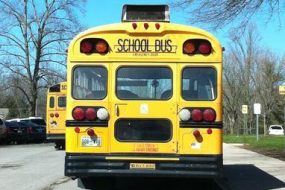
Anything that has to do with school children is treated with caution and carefulness and the reason is not far-fetched. The delicate minds of these young scholars are what triggered that law surrounding school buses.
Since school buses play an important role in the commuting of school children to and from school, ensuring their safety while commuting to and from school is a paramount concern for both parents and authorities. Hence why laws are established to tell you when to pass a school bus and when not to. So, Is it legal to pass a school bus on a two-lane road?
It is legal to pass a school bus on a two-lane road if the bus is on the opposite side of a divided highway with a physical barrier. However, it is illegal to pass a school bus on a two-lane road where traffic flows in both directions, you must come to a complete stop
Is it Legal to Pass a School Bus on a Two-Lane Road?
Yes, it is legal to pass a school bus on a two-lane road if the road is a divided two-lane with a physical barrier and the school bus is on the opposite side of the road. However, it is illegal to pass a school bus on a two-lane road where traffic flows in both directions.
For example, in the United States, the laws governing the passing of school buses vary from state to state; but some fundamental principles are commonly shared. They are:
On a two-lane road, where traffic flows in both directions, the general rule is that all vehicles must come to a complete stop when a school bus is loading or unloading children in order to protect students as they embark or disembark from the bus.
Once the bus stop sign is deployed and the flashing lights are on, you must not pass the school bus if traffic flows in both directions on the two-lane road.
When a school bus comes to a stop and extends its stop sign, it signals that children are either getting on or off the bus. At this point, all traffic in both directions is required to stop.
Failure to do so can lead to severe consequences, as not only is it a violation of traffic laws, but it also puts the lives of young school children at risk.
However, there are some exceptions to this. While the general rule is to stop when a school bus is loading or unloading children on a two-lane road, some exceptions and variations exist.
- Some states may allow passing a school bus on a two-lane road if it is on the opposite side of a divided highway with a physical barrier. In this case, drivers on the opposite side of the road are not required to stop, as the physical barrier provides a level of protection for the children.
- Another exception might occur if a school bus is stopped on a two-lane road, and it is at least 10 feet away from the road. In some states, passing a school bus in this situation may be permissible.
However, it is important to be aware of and adhere to the laws in your jurisdiction regarding the passing of a school bus on a two-lane road because the penalties for unlawfully passing a school bus can be severe. Fines, license points, and even license suspension are common consequences.
Moreover, the chance of causing harm to children is a major factor that underscores the importance of strict enforcement of these laws. In many cases, law enforcement agencies use school bus cameras to capture violations, making it easier to identify and penalize those who put children at risk by disobeying school bus passing laws.
When To Stop for School Bus on a Two-Lane Road
Here are the situations in which you should stop for a school bus on a two-lane road:
1. The School Bus Loading or Unloading Children
The major time you must stop for a school bus on a two-lane road is when the bus is loading or unloading children.
When a school bus comes to a stop and activates its flashing red lights, along with extending the stop sign arm, all traffic in both directions is required to come to a complete stop.
When a school bus is loading or unloading children, it is a critical moment where the safety of students is of utmost importance. The loading and unloading process involves students getting on or off the bus, so you must come to a complete stop provided you are not on the opposite side of the divided road with a physical barrier.
2. No Physical Barrier
If the road is a two-lane road without a physical barrier or divided lanes, you are required to stop when the school bus is loading or unloading children. The absence of a physical barrier emphasizes the need for caution to prevent any risk to the students.
On a two-lane road without a physical barrier, the general rule is that all traffic must come to a complete stop when a school bus is loading or unloading children.
The absence of a physical barrier means that there is no separation between the lanes of traffic, heightening the need for caution and adherence to traffic laws.
The primary reason for requiring all traffic to stop on a two-lane road without a physical barrier is to ensure the safety of students because children who are boarding or alighting from the school bus may need to cross the road, and if there’s no physical barrier or median, the crossing becomes more vulnerable with a higher risk of accidents if passing vehicles do not stop.
3. Approaching from Behind or in the Opposite Lane
If you are driving behind a school bus on a two-lane road and the bus comes to a stop with its flashing red lights activated and the stop sign extended, you are required to come to a complete stop provided the road is not divided with a physical barrier. The stop is necessary to allow students to safely board or exit the bus without the risk of being struck by passing vehicles.
After the school bus has completed the loading or unloading of school children, deactivate its flashing lights and retract the stop sign, you may proceed with caution.
However, you should wait for a clear signal from the bus driver or until you are certain that all students are safely away from the roadway before moving. You should never be in a hurry around the school bus except it’s an emergency.
However, if you are driving on a two-lane road in the opposite direction of the school bus, you are also required to come to a complete stop when the bus is loading or unloading children. This applies even if there is a center turn lane, painted median, or other non-physical barrier separating the lanes.
Except your jurisdiction permits the passage. This is because, some jurisdictions have exceptions when there is a physical barrier, such as a median or divider, between the lanes of traffic. In these cases, drivers on the opposite side of the road may not be required to stop.
4. Flashing Lights and Extended Stop Sign
The school bus’s flashing red lights and the extended stop sign are visual cues indicating that children are either getting on or off the bus. These signals are clear indicators for all drivers to stop, allowing students to safely cross the road.
When a school bus approaches a designated stop, it activates its flashing yellow lights to signal to surrounding drivers that it is preparing to stop. Upon coming to a complete stop, the bus driver deploys the stop sign arm from the driver’s side of the bus, and the red lights begin to flash. The stop sign arm extends, and the red lights indicate that children are about to exit or enter the bus.
5. Physical Distance from the Bus
It’s essential to stop regardless of the physical distance between your vehicle and the school bus. Even if you are a significant distance away, you must come to a complete stop until the bus resumes motion and deactivates its flashing lights and stop sign.
When Should I Not Stop for School Bus on a Two-Lane Road?
Here are common scenarios where you may not need to stop for a school bus on a two-lane road:
- Physical Barrier: If there is a physical barrier, such as a concrete divider or grassy median, separating the lanes of the two-lane road, you may not be required to stop when a school bus on the opposite side is loading or unloading children. The barrier provides additional protection, reducing the risk of students crossing the road in front of oncoming traffic.
- Divided Highway: In some areas, a divided highway with a center turn lane or other separation between the lanes may exempt drivers on the opposite side of the road from stopping for a school bus. The division in the road is considered a safety measure, and drivers on the other side are not as likely to pose a risk to students crossing.
- Designated Turning Lanes: Some municipalities may have specific rules regarding designated turning lanes on two-lane roads. If a turning lane separates your vehicle from the school bus, you may not need to stop. It’s important to understand the specific regulations in your area as exceptions can vary.
- Off-Road Loading or Unloading: If a school bus has pulled off the main road to a designated loading or unloading area, and it is at least 10 feet away from the road, you may not be required to stop. This situation may be permitted in certain jurisdictions, but it’s important to be aware of local laws.
- Traffic Control Devices: Some areas may have traffic control devices or signals in place near school bus stops that dictate when traffic should stop and when it can proceed. Drivers should pay attention to such signals and follow them accordingly.
Nonetheless, it’s important to emphasize that these exceptions are not universal, and local traffic laws can vary, so you need to be aware of the laws regarding school buses in your area and adhere to them.
Conclusion
The law regarding the passing of a school bus on a two-lane road differs from one state to another. While it might be legal to pass a stop school bus when you are on the opposite side of the road with a physical barrier in one state, it might be illegal in another state.
However, the absence of a physical barrier on a two-lane road underscores the need for all vehicles to come to a complete stop when a school bus is loading or unloading children to avoid getting a ticket, ensure the safety of school children, and prevent accidents during these critical moments of bus operations.









